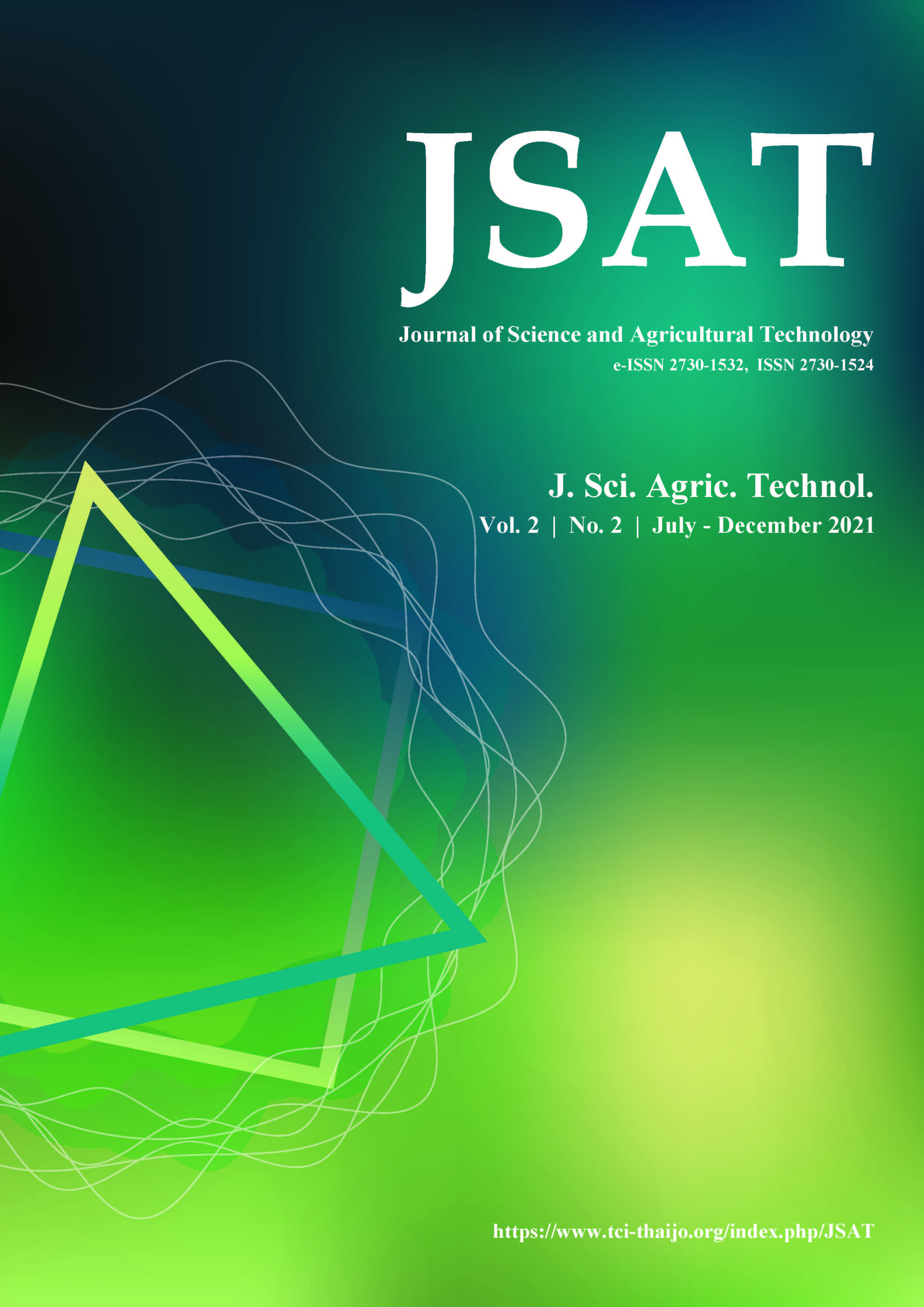Coffivino process: A new era of coffee fermentation
Main Article Content
Abstract
Developing the quality of fermentation is a crucial step in developing regular coffee to specialty coffee. Therefore, the Arabica Research Team, Rajamangala University of Technology Lanna, Thailand, has invented a new fermentation technique called the “Coffivino process.” The aim is to create specialty coffee with a consistent level of quality in every season on an industrial level. This technique is inspired by wine fermentation technology, which combines the Semi-carbonic maceration process with the Yeast process. The new process matches the type and quantity of nutrients with the desired coffee cherry quality. Analyzing and controlling the quality of the entire fermentation process shows that the Coffivino process can create coffee with unique attributes, a wider variety of flavors, and higher intensity than the traditional process. This new technique would be the perfect solution for the fermentation of unhealthy quality coffee cherries on an industrial level and improve them to the sensory quality of specialty coffee.
Article Details
References
Aiemchai, K. 2020. Improving on-farm coffee quality by applying semi-carbonic maceration method. BSc. Research. Rajamangala University of Technology Lanna Lampang, Thailand. (in Thai).
Alves, H.M.R., Volpato, M.M.L., Vieira, T.G.C., Borem, F.M., and Barbosa, J.N. 2011. Características ambientais e qualidade da bebida dos cafes do estado de Minas Gerais. Informe Agropecuario. Belo Horizonte. 32: 1-11.
Ashihara, H., and Crozier A. 2001. Caffeine: A well-known but little mentioned compound in plant science. Trends in Plant Science. 6: 407-413.
Cheng, J.J. 2017. Biomass to renewable energy processes. CRC Press, Taylor and Francis Group, Florida. 449 p.
Coste, R. 1992. Coffee, plant and production. Macmillan Education, London. 328p.
Evangelista, S.R., Silva, C.R., Miguel, M.G.P.C., Cordeiro, C.S., Pinheiro, A.C.M., Duarte, W.F., and Schwan, R.F. 2014. Improvement of coffee beverage quality by using selected yeasts strains during the fermentation in dry process. International Food Research Journal. 61: 183-195.
Haile, M., and Kang, W.H. 2019. The role of microbes in coffee fermentation and their impact on coffee quality. Journal of Food Quality. 2019: 1-6. https://doi.org/10.1155/2019/4836709.
Jearanai, P. 2020. Quality improvement of Arabica green bean coffee by using yeast combined with enzymes. BSc. Research. Rajamangala University of Technology Lanna Lampang. Thailand. (in Thai).
Jitjaroen, W. 2013. Winemaker Handbook. Chiang mai Printing, Chiang mai. 324p. (in Thai).
Jitjaroen, W. 2021. Winemaker Handbook. 2nd ed. N-J Print, Lampang. 347p. (in Thai).
Jitjaroen, W., Kongneong, R., Panjai, L. Jitjaroen, A., and Ta-kham, T. 2021. The impact of innovative coffee processing on the quality of Arabica coffee grown on different altitude areas, with the goal to enhance the export standards of specialty coffee industry on the economic model of new s-curve. Research report. Rajamangala University of Technology Lanna. (in Thai).
Jijaroen, W., Pranamornkit, P., Wuttijaree, K., Jitjaroen, A., Ta-kham, T., Vechagama, K., and Chaimuangchun, P. 2018. Development of a regional enterprise for enhancing Arabica coffee sales across the Asean Free Trade Area (AFTA): an Opportunity for growers and businesses in upper northern Thailand. Research report. (in Thai).
Joet, T., Salmona, J., Laffargue, A., Descroix F., and Dussert, S. 2010. Use of the growing environment as a source of variation to identify the quantitative trait transcripts and modules of co-expressed genes that determine chlorogenic acid accumulation. Plant, Cell and Environment. 33: 1220-1233.
Junior D.B., Guarçoni R.C., da Silva, M.C.S., Veloso, T.G.R., Kasuya, M.M., da Silva, E.C.O., Rodrigues da Luz, J.M.R., Moreira, T.R., Debona, D.G., and Pereira, L.L. 2020. Microbial profile of coffee under carbonic maceration. Food Chemistry. 342. https://doi.org/10.1016/j.foodchem.2020.128296.
Lenoir, J. 1997. Le Nez du Café. R.O.P. Le Muy. 118p.
Liu, L., Wang, Y., Zhao D., An, K., Ding, S., and Wang, Z. 2014. Effect of carbonic maceration pre-treatment on drying kinetics of chilli (Capsicum annuum L.) flesh and quality of dried product. Food Bioprocess Technology. 7: 2516-2527.
LTLH. 2021. LTLH: A gateway of Thai coffee. Available from: https://www.facebook.com/groups/635517163973153/. (in Thai).
Instrução Normativa nº 8. 2003.Regulamento técnico de identidade e de qualidade para a classificação do café beneficiado grão cru (Technical regulation of identity and quality for the classification of raw green coffee beans). Ministério de Estado da Agricultura, Pecuária e Abastecimento Brasil. 1-12. (in Portuguese).
Mahattanatawee, K. 2010. The importance of food flavor and aroma determination by Gas Chromatography-Olfactometry (GC-O). Journal of Food Technology, Siam University. 5:13-17. Available from: https://li01.tci-thaijo.org/index.php/JFTSU/article/view/38385/31804. (in Thai).
Martinez S.J., Bressani A.P.P., Miguel M.G.D.C.P., Dias D.R., and Schwan R.F. 2017. Different inoculation methods for semi-dry processed coffee using yeasts as starter cultures. Food Research International. 102: 333-340. https://doi.org/10.1016/j.foodres.2017.09.096.
Meenakshi, A., and Jagan, L. 2007. An Impression of Coffee Carbohydrates. Critical Reviews in Food Science and Nutrition. 51-67. https://doi.org/10.1080/ 10408390600550315.
Promsri, P. 2018. Carbonic maceration technique influenced the quality of green bean coffee B.Sc. Research. Rajamangala University of Technology Lanna Lampang. (in Thai).
Ribeiro L.S., Da Cruz Pedrozo Miguel, M.G., Evangelista, S.R., Martins, P.M.M., van Mullem, J., Belizario, M.H., and Schwan, R.F. 2017. Behavior of yeast inoculated during semi-dry coffee fermentation and the effect on chemical and sensorial properties of the final beverage. Food Research International. 92: 26-32.
Soykaew, S. 2020. Effect of Semi-carbonic maceration pre-treatment on quality attributes of Arabica coffee during storage. BSc. Research. Rajamangala University of Technology Lanna. Thailand. (in Thai).
Sunarharum, W.B., Williams, D.J., and Smyth, H.E. 2014. Complexity of coffee flavor: A compositional and sensory perspective. Food Research International. 1-22. https://doi.org/10.1016/j.foodres.2014.02.030.
Tesniere, C., and Flanzy, C. 2011. Carbonic maceration wines: characteristics and winemaking process. Advances in Food and Nutrition Research. 63: 01-15.
Upadhyay, R., and Mohan Rao, L.J. 2013. An outlook on chlorogenic acids occurrence, chemistry, technology, and biological activities. Critical Reviews in Food Science and Nutrition. 53: 968-984.
Vaast, P., Bertrand, B., Perriot, J.J., Guyot, B., and Genard, M. 2006. Fruit thinning and shade improve bean characteristics and beverage quality of coffee (Coffea arabica L.) under optimal conditions. Journal of the Science of Food and Agriculture. 86: 197-204.


